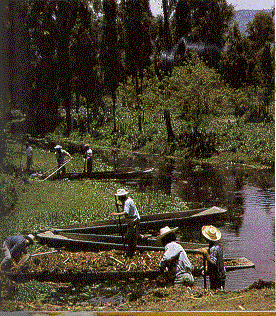
Muck makes good seed beds
 A more arduous method of
harvesting the silt carried by water is to wait until it settles into
drainage canals and then dredge out the muck. This method is
employed in wet areas of south-central Mexico that were turned into
farmable land by a series of drainage canals. Farmers have to
dredge muck out of these canals about once a year in order to keep the
canals from turning into swamps, and the harvested muck makes a high
quality soil amendment.
A more arduous method of
harvesting the silt carried by water is to wait until it settles into
drainage canals and then dredge out the muck. This method is
employed in wet areas of south-central Mexico that were turned into
farmable land by a series of drainage canals. Farmers have to
dredge muck out of these canals about once a year in order to keep the
canals from turning into swamps, and the harvested muck makes a high
quality soil amendment.
Since muck is so energy-intensive to harvest, it is traditionally
poured into small molds made by mounding up a soil lip around four
sides of a rectangle on the ground. The water quickly soaks into
the underlying soil, leaving a rectangle of solidified muck that can be
cut into small squares. A seed is planted into each square, then
the resulting seedlings are transplanted into the main fields.
The muck seed bed gives the seedlings a good start on life, and the
cubes of muck are a good amendment to the regular seedbed after
transplanting.
We certainly have plenty of muck going to waste on our farm.
Previous owners rerouted the main creekbed, leaving behind an old
creekbed that we've dubbed the alligator swamp. I suspect that we
could harvest many buckets of muck out of the swamp and add the high
fertility soil to our garden with the help of the golf cart.
This week's lunchtime series only
covered the first third of Good Farmers. Stay tuned for another series if I
get my act together before the library book is due!
| This post is part of our Central American Permaculture lunchtime
series.
Read all of the entries: |
Want more in-depth information? Browse through our books.
Or explore more posts by date or by subject.
About us: Anna Hess and Mark Hamilton spent over a decade living self-sufficiently in the mountains of Virginia before moving north to start over from scratch in the foothills of Ohio. They've experimented with permaculture, no-till gardening, trailersteading, home-based microbusinesses and much more, writing about their adventures in both blogs and books.
Want to be notified when new comments are posted on this page? Click on the RSS button after you add a comment to subscribe to the comment feed, or simply check the box beside "email replies to me" while writing your comment.
